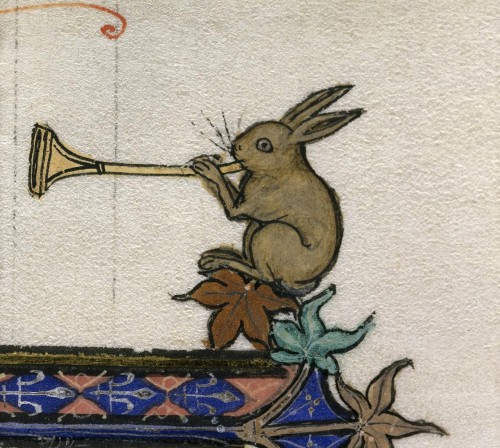The following comes from a 1906 master’s thesis by Allie V. Parks titled, “Stage Properties, Costumes, Scenery and Music of the English Miracle Plays†(see part 1 here and part 2 here). These were religious pageants performed in England from the 10th to the 16th centuries. I’ve reformatted the text a bit to make it a little more readable, since it is already challenging trying to decipher the Middle English text:
In the Crucifixion scene a cross seemed actually to be used. Chambers quotes on page 276 from “The Hall book of the Corporation at Leicester, 1504. Paid for mending the garment of Jesus and the cross painting“. In the Shakespeare Society Chester Plays, in the play ‘The Histories of Lot and Abraham’ p. 59. here the Messenger doth offer to Melchesadecke a standinge cupe and bredde, and again on page 61, Here Lotte dothe offer to Melchesadecke a goodly cupe. Undoubtedly a cup was part of the properties in this play. On page 72 Abraham is directed to “kisse his sonne Isaake, and bynde a charchaffe aboute his heade“. Page 49 of the same edition, in the ‘Noah’ play, the following directions regarding the building of the Ark occur: Then Noye with all his family shall make a signe as though the wroughte upon the shippe with diverse instruments, and after that God shall speake to Noye, sayinge,
This direction would seem to show that a sort of pantomimic performance was gone through with and not any real work in the Ark building.
I found one reference to the use of straw, on page 370 of Chambers ‘Mediaeval Plays’ in the accounts of the Trinity House at Hull, Yorkshire: “Straw, for Noah and his children ijd.”
The stage directions for the use of animals are very few. The Chester Plays of the Shakespeare Society give on page 74, Then let Abraham take the lambe and kille him, and on page 150, Then the kinges goe downe to the beastes and ryde aboute. It seems hardly probable that Abraham really offered a lamb in place of his son, but he may have gone through the motions of doing so. This is the only stage direction in any of the cycles which might lead to the supposition that a lamb was really used for the sacrifice.
I have already quoted the directions for the use of horses on page 150, Then the kinges goe down to the beastes and ryde aboute. There is one other reference to the use of horses on page 253 of this edition of the Chester Plays, in ‘The Entry Into Jerusalem,’ Here Cryst rydyth out of the place; The animal may have been an ass; there is nothing to indicate what animal he rode upon.
There is one stage direction regarding the use of fowls in the Coventry cycle. This occurs on page 178 as follows: and ther Mary offery the ffowlys onto the auterre, and seyth.
Parks, Allie V. “Stage Properties, Costumes, Scenery and Music of the English Miracle Plays.†Thesis. University of Illinois, 1906. Internet Archive, 29 Oct. 2013. Web. 18 Oct. 2016. <https://archive.org/details/stagepropertiesc00park>.

